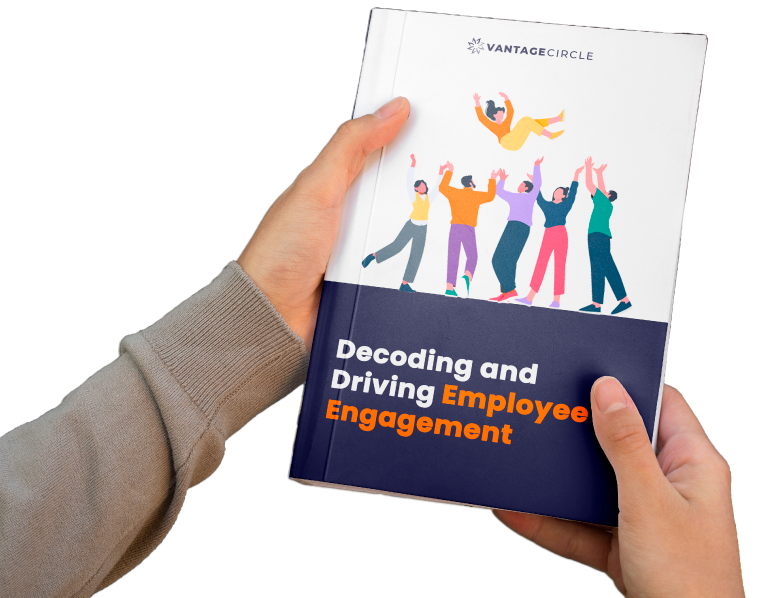The link between employee voice and organizational performance

A Global Employee Recognition and Wellness Platform
When people feel heard, everything changes. Not just how they show up—but how the whole organization moves forward. Teams become more invested, innovation gets a boost, and trust grows stronger. In fact, research shows that companies with high employee engagement—fueled by open communication—are 21% more profitable and see 59% less turnover (Gallup).
This is the power of employee voice, not just the right to speak up, but the confidence that what’s said will be heard, valued, and acted on. In today’s workplace, it’s no longer a nice-to-have; it’s a performance strategy. And when done right, it can turn quiet frustration into bold progress.
What is Employee Voice and Why Does It Matter Now More Than Ever?
Defining the Modern Employee Voice: More Than Just Feedback
Employee voice today isn’t just about giving feedback, it’s about creating a culture where people feel safe to speak up and confident they’ll be heard. It’s the difference between checking a box and starting a conversation.
And it pays off. Companies with inclusive, open cultures are 6x more likely to be innovative and 2x more likely to hit financial targets (Deloitte).
From Annual Surveys to Continuous Conversations
Once-a-year surveys? They’re not enough anymore. Today’s employees expect ongoing, honest conversations—through pulse checks, 1:1s, open forums, and even Slack.
Companies that keep feedback flowing in real time see real results—like up to 20% lower attrition ( McKinsey). Because when people see action, they stay engaged.
The Four Pillars of Effective Employee Voice
A strong voice strategy rests on four essentials:
Expression – People feel safe to speak up.
Being Heard – Their words don’t disappear into a void.
Being Listened To – Leaders take time to understand.
Influencing Action – Feedback leads to change.
Get these right, and you don’t just hear your people—you empower them.
In an Era of Transformation, Listening Is a Leadership Imperative
"Listening is the new leadership skill. In fast-changing workplaces, it’s non-negotiable."
When everything’s shifting—how we work, where we work, why we work—listening isn’t just nice to have; it’s critical. Employees today want more than a paycheck. They want purpose, flexibility, and to know their voice makes a difference. And when they don’t get that? They leave.
The Great Resignation and the Demand for Meaningful Work
The mass workplace exodus wasn’t just about burnout, it was about people reassessing what matters. According to McKinsey, 70% of employees say their sense of purpose is defined by their work. And when they don’t feel heard or valued, they’re more likely to walk.
Employee voice plays a huge role here. When people feel they can speak up and drive impact, they’re more connected—and more likely to stay.
The Rise of Remote and Hybrid Work Models
With teams spread across homes, cities, and time zones, it's easy for people to feel disconnected. That’s why listening needs to be intentional.
A report by Microsoft found that employees who feel their voice is heard are 4.6x more likely to feel empowered to perform their best (Microsoft Work Trend Index). Whether it’s regular check-ins, async feedback, or digital suggestion boxes—leaders need new ways to stay tuned in.
Because when distance grows, listening bridges the gap.
The Tangible Link: How Employee Voice Boosts Organizational Performance
When people feel heard, they care more. They try harder. They stick around. Giving employees a voice doesn’t just boost morale—it boosts results. And the numbers prove it.
According to research by Hive, 96% of employees say they’re more engaged when they feel heard. On the flip side, Gallup’s State of the Global Workplace report shows that only 23% of employees are actively engaged worldwide. That’s a huge gap—and it shows just how powerful listening can be.
Increased Employee Engagement and Motivation
People want to be part of something that listens. When their ideas matter, so does their work. They show up with more energy, more care, and more purpose. That’s what real engagement looks like.
The Psychological Impact of Being Heard
Being heard feels good. It builds trust. It makes people feel like they belong.
And when people feel valued, they give more. Not because they have to—but because they want to. That’s called discretionary effort.
One Forbes study found that 74% of employees say they do better work when they feel heard (Forbes). That’s huge.
Data-Backed Correlation Between Voice and Engagement Levels
Here’s the kicker: when employees feel heard, 96% feel more engaged (Hive).
Now compare that to the global engagement average—just 23% (Gallup). Big difference, right?
Bottom line: when you listen, people lean in.
Enhanced Innovation and Problem-Solving
Great ideas don’t just come from the top. They come from everywhere—especially when people feel safe to speak up. When companies truly listen, they tap into a goldmine of creativity and insight.
Unlocking Collective Intelligence for Better Decisions
The more voices you include, the smarter your decisions get. Teams that bring in diverse perspectives are 87% better at making decisions (Cloverpop).
Why? Because different people see different angles. Someone on the frontlines might spot a flaw leadership missed. Another might offer a solution no one considered. It’s not just collaboration—it’s collective intelligence.
Case in Point: Companies That Innovated by Listening
Take Adobe. They replaced annual performance reviews with real-time feedback after employees said traditional reviews were demotivating. The result? Higher engagement and faster development cycles.
Or look at Google. Their famous “20% time” policy—giving employees freedom to pursue ideas—led to products like Gmail and Google Maps. That’s the power of listening in action.
Higher Rates of Employee Retention and Reduced Turnover Costs
People don’t leave jobs—they leave cultures where they feel unheard. When employees know their voice matters, they’re more likely to stay. And that loyalty saves companies a lot of money.
Creating a Culture of Loyalty and Trust
Trust is built through listening. When employees feel heard, they feel respected—and respect creates roots.
According to Salesforce, employees who feel their voice is heard are 4.6x more likely to feel empowered to do their best work. That sense of purpose and connection makes it harder to walk away.
The Staggering Financial Cost of Employee Turnover
Losing people is expensive. Like, really expensive. Gallup estimates the cost of replacing an employee is anywhere from 50% to 200% of their annual salary.
So when companies invest in listening—through feedback channels, transparent communication, and inclusive leadership—they’re not just keeping people happy. They’re saving serious money.
Improved Customer Satisfaction and Loyalty
Happy employees = happy customers. It’s that simple. When people enjoy their work and feel heard, it shows in every interaction—with each other and with customers.
The Direct Line from Employee Experience (EX) to Customer Experience (CX)
Engaged employees go the extra mile—and customers feel the difference. According to Temkin Group, companies that excel in customer experience have 1.5x more engaged employees.
When employees feel supported, valued, and empowered, they naturally deliver better service. It’s not about scripts—it’s about energy and attitude.
Frontline Employees as a Source of Invaluable Customer Insights
No one knows your customers better than the people talking to them every day. Frontline employees hear the complaints, the compliments, the "almost bought but…" stories.
Listening to those voices can shape better products, smoother processes, and stronger loyalty. In fact, a study by PwC found that 73% of customers say experience is a key factor in their purchasing decisions, and that experience often starts with the employee.
How to Implement a Culture of Employee Voice in Your Organisation
Creating a culture where people feel safe and excited to speak up doesn’t happen by chance—it takes intention, consistency, and follow-through. Here’s how to make it real (and stick).
Securing Leadership Buy-In and Leading by Example
Employee voice starts at the top. When leaders actively listen and show they value feedback, it sets the tone.
According to a Harvard Business Review study, leaders who listen well are seen as 5x more effective and are 21x more likely to be trusted. That kind of trust is the foundation for honest conversations.
Training Managers to Be Receptive and Responsive
Managers are the everyday face of leadership. If they shut down ideas or ignore concerns, employee voice dies fast.
Equip them with training on active listening, empathetic leadership, and how to respond thoughtfully. According to Gallup, 70% of team engagement is driven by the manager. They matter—a lot.
Establishing Clear Channels and Closing the Feedback Loop
No one wants to yell into the void. Whether it’s through surveys, open forums, anonymous tools, or 1:1s, give employees multiple ways to speak up.
And don’t stop there—closing the loop is key. Let people know what’s being done with their input. Transparency = trust.
Recognition and Rewards: Amplifying Positive Contributions
When someone shares a great idea—or even a brave concern—celebrate it. Public recognition shows others that speaking up is not just accepted, it’s appreciated.
Companies with strong recognition programs have 31% lower voluntary turnover (Bersin by Deloitte). People stay where they feel seen.
Integrating Feedback into Your Business Rhythms
Don’t make feedback a one-off event. Weave it into the everyday—team check-ins, sprint retros, all-hands meetings, quarterly planning.
When feedback becomes part of how you work, it becomes part of who you are as a company.
The Role of Modern Technology in Enabling Employee Voice
Employee voice doesn’t thrive on good intentions alone—it needs structure, consistency, and the right tools. Modern platforms make it easier than ever to listen, respond, and act in real time. Here's how technology turns talk into transformation.
Moving Beyond the Suggestion Box with a Centralised Platform
Let’s face it—traditional feedback methods are outdated and easy to ignore. What organisations need today is a centralised, easy-to-use platform where feedback, recognition, and insights all live in one place.
A single system ensures nothing slips through the cracks. It helps leaders track trends, respond faster, and show employees that their voice is being taken seriously—not stuck in an unread inbox.
Recognition and Rewards: Amplifying and Encouraging Valuable Input
Recognition isn’t just a “nice-to-have”—it’s how you fuel a culture of openness. When employees are celebrated for speaking up, others are encouraged to do the same.
In fact, companies with high recognition cultures are 2.5x more likely to see increased employee engagement (SHRM). A platform that links recognition to real contributions—like new ideas, problem-solving, or constructive feedback—makes it easy to reinforce the right behaviors at scale.
Pulse Surveys: Your Real-Time Organizational Health Check
You can’t fix what you don’t see. And in today’s fast-moving workplace, waiting months to hear how your people feel is just too late. That’s where Vantage Pulse comes in.
Vantage Pulse is a lightweight, intuitive employee survey tool designed for real-time feedback. It helps you measure engagement, spot trends, and identify red flags—before they become bigger problems.
Short, regular pulse surveys mean less survey fatigue and more honest responses. And with easy-to-read dashboards, you get actionable insights you can actually use.
Plus, the impact is real. Companies using frequent employee feedback tools report 14% lower turnover and more agile decision-making (Officevibe).
Vantage Pulse keeps you connected to your people—consistently, clearly, and without the noise.
Your People Are Your Greatest Asset – It's Time to Listen
At the heart of every successful business isn’t just a product or process—it’s people. The ones solving problems, building relationships, and pushing ideas forward. And when those people feel heard, everything else gets better: morale, retention, innovation, performance.
Employee voice isn’t a trend—it’s a competitive advantage.
Listening isn’t just about gathering feedback. It’s about showing your team they matter, their ideas count, and their experiences shape the future of your organization.
So if you're serious about building a culture that thrives, it starts with one simple act: listening better, and more often.
Don’t just collect feedback—act on it. Explore how tools like Vantage Pulse can help you build a workplace where every voice drives real change.
















